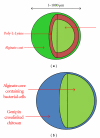The gut microbiota and human health with an emphasis on the use of microencapsulated bacterial cells
- PMID: 21772792
- PMCID: PMC3134400
- DOI: 10.1155/2011/981214
The gut microbiota and human health with an emphasis on the use of microencapsulated bacterial cells
Abstract
The gut microbiota plays a crucial role in maintaining health. Alterations of the gut bacterial population have been associated with a number of diseases. Past and recent studies suggest that one can positively modify the contents of the gut microbiota by introducing prebiotics, probiotics, synbiotics, and other therapeutics. This paper focuses on probiotic modulation of the gut microbiota by their delivery to the lower gastrointestinal tract (GIT). There are numerous obstacles to overcome before microorganisms can be utilized as therapeutics. One important limitation is the delivery of viable cells to the lower GIT without a significant loss of cell viability and metabolic features through the harsh conditions of the upper GIT. Microencapsulation has been shown to overcome this, with various types of microcapsules available for resolving this limitation. This paper discusses the gut microbiota and its role in disease, with a focus on microencapsulated probiotics and their potentials and limitations.
Figures



References
-
- Cani PD. The role of the gut microbiota in energy metabolism and metabolic disease. Current Pharmaceutical Design. 2009;15(13):1546–1558. - PubMed
-
- Guarner F, Malagelada JR. Gut flora in health and disease. The Lancet. 2003;361(9356):512–519. - PubMed
-
- Salminen S, Bouley C, Boutron MC, et al. Functional food science and gastrointestinal physiology and function. British Journal of Nutrition. 1998;80(supplement 1):S147–S171. - PubMed
-
- Tilg H, Moschen AR, Kaser A. Obesity and the microbiota. Gastroenterology. 2009;136(5):1476–1483. - PubMed
Publication types
MeSH terms
Grants and funding
LinkOut - more resources
Full Text Sources
Other Literature Sources
Medical
Miscellaneous

